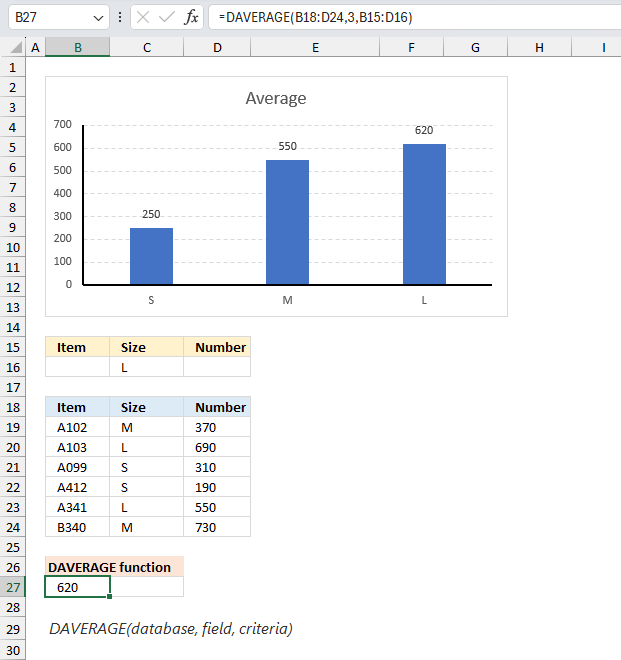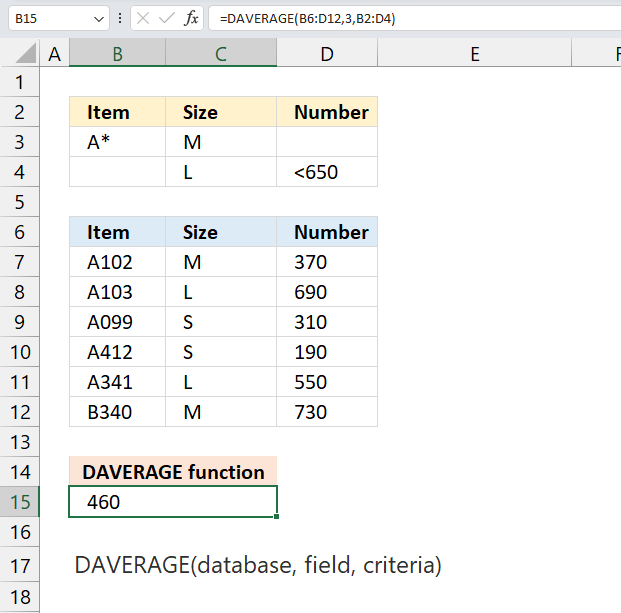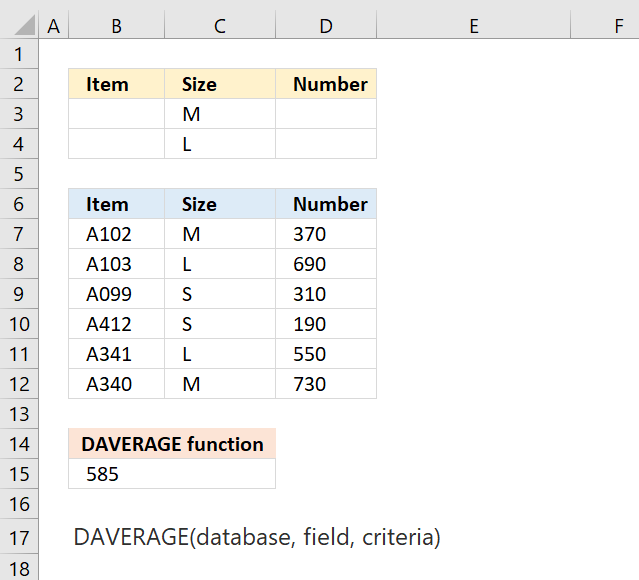How to use the DAVERAGE function
What is the DAVERAGE function?
The DAVERAGE function calculates an average based on values in a list or database that meet specific conditions.
Table of Contents
1. Introduction
What is the average?
It is also known as the mean. It is calculated by adding up all the values in the data set and dividing by the number of values.
Arithmetic mean = (Σxi)/n
xi = each number
n = count of all numbers
For example, if you have a data set of 5, 7, 9, 11, and 13, the mean is (5 + 7 + 9 + 11 + 13) / 5 = 9.
When is the average useful?
- Average test score in a class: Calculating the average test score gives teachers an overall measure of how the class performed on the test.
- Average monthly expenses: Individuals or households can calculate their average monthly expenses to understand their typical spending patterns, budget more effectively, and identify areas where they can potentially reduce costs.
- Average customer rating: Companies often calculate the average customer rating for their products or services to gauge overall customer satisfaction and identify areas for improvement.
- Average daily traffic: Transportation authorities measure the average daily traffic on roads or highways to plan infrastructure upgrades, manage traffic flow, and allocate resources accordingly.
- Average sales per employee: Businesses can calculate the average sales per employee to evaluate the productivity and performance of their sales team.
Here are five mathematical formulas that require the calculation of an average:
- Variance: Σ(x - μ)^2 / (n - 1)
Where μ is the mean (average) of the data set, and n is the number of observations. - Standard Deviation: √[Σ(x - μ)^2 / (n - 1)]
Where μ is the mean (average) of the data set, and n is the number of observations. - Correlation Coefficient: r = Σ[(x - x̄)(y - ȳ)] / √[Σ(x - x̄)^2 * Σ(y - ȳ)^2]
Where x̄ and ȳ are the means (averages) of the respective data sets. - Linear Regression: y = a + bx
Where a = ȳ - b * x̄, and b = Σ[(x - x̄)(y - ȳ)] / Σ(x - x̄)^2
x̄ and ȳ are the means (averages) of the independent and dependent variables, respectively. - Confidence Intervals: x̄ ± z * (σ / √n)
Where x̄ is the mean (average) of the sample, and n is the number of observations.
Does the DAVERAGE function count blank cells, boolean, and text values?
No, blank cells, boolean values and text values are not counted.
Does the DAVERAGE function ignore error values?
Yes, it ignores error values.
What is DAVERAGE an abbreviation of?
DAVERAGE is an abbreviation of Database Average.
What is a database in this context?
Excel defines a database as a list of related data in which rows of related information are records, and columns of data are fields. The first row of the list contains labels for each column.
Why use the DAVERAGE function?
The DAVERAGE function calculates the average of cells containing numbers that match a condition or criteria in a list/database whereas the AVERAGE function calculates an average without a condition/criteria.
Where can you place the criteria range?
You can place your criteria range wherever you want on your worksheet, however, it is not recommended below the list/database. The function needs a blank row below the list to work properly.
What criteria characters are allowed?
Allowed criteria range characters are less than and greater than signs <>, use them to specify a criteria range. Also, asterisks * can be used to match partial strings.
How to calculate the AVERAGE for the entire list/database?
To include the entire list/database enter a blank line below the criteria range column labels.
2. Syntax and Arguments
DAVERAGE(database, field, criteria)
| database | Required. The cell reference to a list or database. |
| field | Required. The field argument lets you choose which column to use. You can use the column name enclosed with double quotation marks or the corresponding column number. |
| criteria | Required. A cell reference to the criteria range. The criteria range needs to have column labels and a at least one condition below the column label. |
3. Example 1

This example demonstrates how to use the DAVERAGE function to filter values based on a single condition and calculate the average (arithmetic mean) for corresponding numbers on the same row.
The data in cell range B18:D24:
| Item | Size | Number |
| A102 | M | 370 |
| A103 | L | 690 |
| A099 | S | 310 |
| A412 | S | 190 |
| A341 | L | 550 |
| B340 | M | 730 |
The condition is in cell range B15:D16:
| Item | Size | Number |
| L |
The arguments are:
database = B18:D24
field = 3
criteria = B15:D16
Formula in cell B27:
The formula returns 620. Cells that match the condition are C20 and C23, the corresponding cells in column D are D20 and D23. Those cells contain the following numbers: 690 and 550.
The arithmetic mean (average) is 690 + 550 = 1240. 1240 / 2 = 620. The formula is correct. The image above shows a bar chart chart displaying the average for each "size" based on the data in cell range B18:D24.
4. Example 2
This example demonstrates how to use the DAVERAGE function using criteria with OR logic. The criteria are specified in cells B2:D4, the column header names must be specified as well in order to work properly.
The "Size" column has two conditions "M" and "L" and they are in a row each meaning OR logic is performed. This checks if either "M" or "L" is in the database B7:D12 in column "Size" and extracts numbers from column "Number" on the same row.
The data is in cell range B6:D12, here it is:
| Item | Size | Number |
| A102 | M | 370 |
| A103 | L | 690 |
| A099 | S | 310 |
| A412 | S | 190 |
| A341 | L | 550 |
| A340 | M | 730 |
The arguments are:
database = B6:D12
field = 3
criteria = B2:D4
Formula in cell B15:
The formula calculates the average of the numbers in column "Number" if the "Size" is M or L. Cells D7, D8, D11, and D12 match and they contain 370, 690, 550, and 730.
The total is 370 + 690 + 550 + 730 equals 2340. To calculate the average we divide the total by the count: 2340 / 4 equals 585.
5. Example 3

This example demonstrates how to combine four conditions and perform AND and OR logic. The criteria are specified in cells B2:D4, the column header names must be specified as well in order to work properly.
The data is in cell range B6:D12, here it is:
| Item | Size | Number |
| A102 | M | 370 |
| A103 | L | 690 |
| A099 | S | 310 |
| A412 | S | 190 |
| A341 | L | 550 |
| B340 | M | 730 |
The arguments are:
database = B6:D12
field = 3
criteria = B2:D4
The "Item" column has a condition that checks if the values begin with an "A", the asterisk matches 1 to many characters of any kind. The "Size" column has a "M" specified on the same row as the "Item" condition which means that both conditions must be met, in other words, AND logic.
The next row (4) has "L" in "Size" column and "<650" in the "Number" column, both these conditions must be met. Since two conditions are entered in row 3 and two conditions are entered in row means that there is OR logic applied between these condition pairs.
So if the conditions in row 3 are met or the conditions in row 4 are met in order to include the corresponding number in the average calculation.
Formula in cell B15:
Row 7 meets both the conditions in row 3, number 370 is included in the calculation. Row 8 does not meet any of the condition pairs specified in rows 3 and 4, number 690 is not included.
The same thing applies to row 9 and 10, none of the condition pairs match. Number 310 and 190 are not included. Row 11 matches the condition pair specified in row 4, number 550 is included. Row 12 doesn't match any of the condition pairs.
The filtered numbers are 370 and 550, the total is 370 + 550 equals 920. 920 / 2 equals 460.
6. Function not working

The DAVERAGE function returns
- #DIV/0! error if the condition/criteria is not found in the database argument.
- #NAME? error if you misspell the function name.
- propagates errors, meaning that if the input contains an error (e.g., #VALUE!, #REF!), the function will return the same error.
6.1 Troubleshooting the error value

When you encounter an error value in a cell a warning symbol appears, displayed in the image above. Press with mouse on it to see a pop-up menu that lets you get more information about the error.
- The first line describes the error if you press with left mouse button on it.
- The second line opens a pane that explains the error in greater detail.
- The third line takes you to the "Evaluate Formula" tool, a dialog box appears allowing you to examine the formula in greater detail.
- This line lets you ignore the error value meaning the warning icon disappears, however, the error is still in the cell.
- The fifth line lets you edit the formula in the Formula bar.
- The sixth line opens the Excel settings so you can adjust the Error Checking Options.
Here are a few of the most common Excel errors you may encounter.
#NULL error - This error occurs most often if you by mistake use a space character in a formula where it shouldn't be. Excel interprets a space character as an intersection operator. If the ranges don't intersect an #NULL error is returned. The #NULL! error occurs when a formula attempts to calculate the intersection of two ranges that do not actually intersect. This can happen when the wrong range operator is used in the formula, or when the intersection operator (represented by a space character) is used between two ranges that do not overlap. To fix this error double check that the ranges referenced in the formula that use the intersection operator actually have cells in common.
#SPILL error - The #SPILL! error occurs only in version Excel 365 and is caused by a dynamic array being to large, meaning there are cells below and/or to the right that are not empty. This prevents the dynamic array formula expanding into new empty cells.
#DIV/0 error - This error happens if you try to divide a number by 0 (zero) or a value that equates to zero which is not possible mathematically.
#VALUE error - The #VALUE error occurs when a formula has a value that is of the wrong data type. Such as text where a number is expected or when dates are evaluated as text.
#REF error - The #REF error happens when a cell reference is invalid. This can happen if a cell is deleted that is referenced by a formula.
#NAME error - The #NAME error happens if you misspelled a function or a named range.
#NUM error - The #NUM error shows up when you try to use invalid numeric values in formulas, like square root of a negative number.
#N/A error - The #N/A error happens when a value is not available for a formula or found in a given cell range, for example in the VLOOKUP or MATCH functions.
#GETTING_DATA error - The #GETTING_DATA error shows while external sources are loading, this can indicate a delay in fetching the data or that the external source is unavailable right now.
6.2 The formula returns an unexpected value

To understand why a formula returns an unexpected value we need to examine the calculations steps in detail. Luckily, Excel has a tool that is really handy in these situations. Here is how to troubleshoot a formula:
- Select the cell containing the formula you want to examine in detail.
- Go to tab “Formulas” on the ribbon.
- Press with left mouse button on "Evaluate Formula" button. A dialog box appears.
The formula appears in a white field inside the dialog box. Underlined expressions are calculations being processed in the next step. The italicized expression is the most recent result. The buttons at the bottom of the dialog box allows you to evaluate the formula in smaller calculations which you control. - Press with left mouse button on the "Evaluate" button located at the bottom of the dialog box to process the underlined expression.
- Repeat pressing the "Evaluate" button until you have seen all calculations step by step. This allows you to examine the formula in greater detail and hopefully find the culprit.
- Press "Close" button to dismiss the dialog box.

There is also another way to debug formulas using the function key F9. F9 is especially useful if you have a feeling that a specific part of the formula is the issue, this makes it faster than the "Evaluate Formula" tool since you don't need to go through all calculations to find the issue..
- Enter Edit mode: Double-press with left mouse button on the cell or press F2 to enter Edit mode for the formula.
- Select part of the formula: Highlight the specific part of the formula you want to evaluate. You can select and evaluate any part of the formula that could work as a standalone formula.
- Press F9: This will calculate and display the result of just that selected portion.
- Evaluate step-by-step: You can select and evaluate different parts of the formula to see intermediate results.
- Check for errors: This allows you to pinpoint which part of a complex formula may be causing an error.
The image above shows cell reference B15:D16 converted to hard-coded value using the F9 key. The DAVERAGE function requires valid criteria which is not the case in this example. We have found what is wrong with the formula.
Tips!
- View actual values: Selecting a cell reference and pressing F9 will show the actual values in those cells.
- Exit safely: Press Esc to exit Edit mode without changing the formula. Don't press Enter, as that would replace the formula part with the calculated value.
- Full recalculation: Pressing F9 outside of Edit mode will recalculate all formulas in the workbook.
Remember to be careful not to accidentally overwrite parts of your formula when using F9. Always exit with Esc rather than Enter to preserve the original formula. However, if you make a mistake overwriting the formula it is not the end of the world. You can “undo” the action by pressing keyboard shortcut keys CTRL + z or pressing the “Undo” button
6.3 Other errors
Floating-point arithmetic may give inaccurate results in Excel - Article
Floating-point errors are usually very small, often beyond the 15th decimal place, and in most cases don't affect calculations significantly.
Functions in 'Database' category
The DAVERAGE function function is one of 11 functions in the 'Database' category.

How to comment
How to add a formula to your comment
<code>Insert your formula here.</code>
Convert less than and larger than signs
Use html character entities instead of less than and larger than signs.
< becomes < and > becomes >
How to add VBA code to your comment
[vb 1="vbnet" language=","]
Put your VBA code here.
[/vb]
How to add a picture to your comment:
Upload picture to postimage.org or imgur
Paste image link to your comment.
Contact Oscar
You can contact me through this contact form